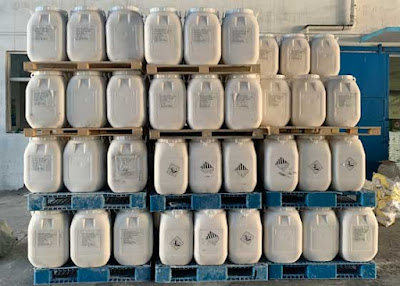Introduction of Water Treatment Process in Water Supply Company
1. The raw water enters the distribution well, where large and heavy suspended particles settle. The raw water is equally divided into two parts and enters the sedimentation tank through the pipeline connected with the sedimentation tank. There is an incoming turbidity detector in the water distribution well.
2. The distributed water passes through a tubular mixer before entering the sedimentation tank, where the raw water is added to the coagulant (PAC solution, the main component AL2O3). After entering the flocculation tank, the raw water passes through 48 layers of grids, and the flow rate is further slowed down. The suspended solids and colloidal impurities contained in the raw water react with the coagulant to produce flocculent sedimentation, and part of the flocculation sediments in the flocculation tank. There is a buffer zone between the flocculation tank and the sedimentation area to stabilize the water flow and slowly enter the sedimentation area. The sedimentation area is equipped with a honeycomb inclined pipe (2.5cm in diameter), and the water enters the inclined pipe from below the sedimentation area with a flow rate of 2mm/s. During the ascending process, the flocs further sink, and the water finally flows into the sump in the sedimentation area, and flows to the filter tank through the pipeline.
3. The effluent from the sedimentation tank enters the key part of the filter tank. After the filter material is filtered for a long time, the impurities will gradually increase, the water permeability will be weakened, the water pressure of the upper layer of the filter material will gradually increase, and the water level will begin to rise. When the water level rises to the highest point of the siphon pipe and flows to the siphon downcomer, negative pressure is generated below the cone hood, and backwashing begins. The water in the upper storage tank of the cone hood enters from below the filter material through the connecting channel, and the impurities in the filter material are washed and followed The rising water flows out of the filter tank through the siphon. When the water level in the water storage tank on the upper part of the conical cover drops to the siphon destruction bucket, air enters the siphon tube, the siphon phenomenon is destroyed, the backwashing stops immediately, and the normal filtration process starts to run. Backwashing can be carried out automatically, or forced backwashing with pressure water can be manually opened.
4. When the filtered water enters the clean water tank, it is added with chlorine disinfection chemical. After entering the clear water tank, under the action of the diversion wall, the water flow zigzags forward, prolonging the disinfection reaction time. The clean water tank is used to store purified clean water and can adjust the difference between the water supply and the water demand. A sampling pump is installed on the outlet pipe of the clean water tank, and the sampled water is pumped to the factory turbidity meter and residual chlorine analyzer.
5. The degree of automation is high. The chlorination and dosing equipment, the imported and delivered turbidity meter, and the residual chlorine analyzer are all connected to the computer in the central control room. The dosage can be carried out by the computer according to the turbidity of the raw water and the turbidity of the factory water. Automatic adjustment to ensure that the turbidity of the factory water meets the drinking water standard. The chloride ion content of the factory water can also be adjusted by the computer-controlled chlorine dioxide generator to meet the chloride ion content at the end of the pipe network and ensure the safety of drinking water.




Comments
Post a Comment